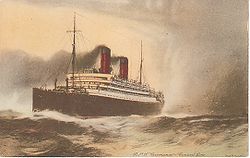RMS Carmania
|
||||||||||||||||||||
|
||||||||||||||||||||
|
||||||||||||||||||||
|
||||||||||||||||||||
|
||||||||||||||||||||
The RMS Carmania (I) was a transatlantic liner put into service in 1905 for the British shipping company Cunard Line , which was used as an auxiliary cruiser in the First World War . After the war she was again active in passenger traffic until she was decommissioned in 1931 and scrapped in Blyth the following year .
The ship
The ship was launched on February 21, 1905 at John Brown & Company in Clydebank and began its maiden voyage on December 2, 1905. When the Carmania and her sister ship , the RMS Caronia (I), started liner service between Liverpool and New York , they were the largest ships in the Cunard fleet.
After the outbreak of war, the Carmania was converted into an auxiliary cruiser by the British Royal Navy in Liverpool and ordered to the Caribbean under the command of Captain Noel Grant to patrol there and in the northern South Atlantic. On the morning of September 14, she discovered the German auxiliary cruiser Cap Trafalgar , also a former passenger steamer, on the coal off the Brazilian island of Trindade . The two ships then fought a bitter battle, in which both sides suffered severe damage from artillery strikes and fire. When the fires on the Carmania seemed to get out of hand, the Cap Trafalgar turned abruptly and lowered her lifeboats into the water. The German ship developed quickly flip side and began to sink. A hit below the waterline had caused several bulkheads to collapse. The two coal ships ( Pontos and Eleonore Woermann ) that had lain with her before Trindade recovered 279 men of the crew and brought them to Montevideo ; 51 men were killed in the battle or in the sinking, including the commander, Korvettenkapitän Wirth.
The Carmania was also in very bad shape - with severe flip side , water in the ship on fire, with nine dead and many wounded. The German auxiliary cruiser Kronprinz Wilhelm , who appeared on the scene shortly afterwards and was brought in by the radio information about the position of Cap Trafalgar , could have put an end to it, but feared a trap, as the radio messages from the Carmania had probably also summoned British warships . The Crown Prince Wilhelm therefore turned away without firing a shot and ran away.
The Carmania was directed to Pernambuco by other Royal Navy ships the next day . It was repaired in Gibraltar and then used in Portugal and the Atlantic Islands. In 1916 she was involved as a troop transport in an attempt to land in Gallipoli and break through the Dardanelles . After that it served as a troop transport until the end of the war and finally after the end of the war to transport Canadian soldiers home.
From 1920 she was back in passenger service. Despite modernization in 1923, it was too outdated and was scrapped in 1932.
Web links
- S / S Carmania, Cunard Line
- Caronia and Carmania - The Cabin Channel Steamers
- Carmania (I) - greatoceanliners.net
- Carmania I - Cunard: The Most Famous Ocean Liners in the World


